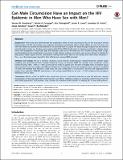| dc.contributor.author | Goodreau, Steven M. | en_US |
| dc.contributor.author | Carnegie, Nicole B. | en_US |
| dc.contributor.author | Vittinghoff, Eric | en_US |
| dc.contributor.author | Lama, Javier R. | en_US |
| dc.contributor.author | Fuchs, Jonathan D. | en_US |
| dc.contributor.author | Sanchez, Jorge | en_US |
| dc.contributor.author | Buchbinder, Susan P. | en_US |
| dc.date.accessioned | 2014-09-08T15:36:12Z | |
| dc.date.issued | 2014 | en_US |
| dc.identifier.citation | Goodreau, Steven M., Nicole B. Carnegie, Eric Vittinghoff, Javier R. Lama, Jonathan D. Fuchs, Jorge Sanchez, and Susan P. Buchbinder. 2014. “Can Male Circumcision Have an Impact on the HIV Epidemic in Men Who Have Sex with Men?” PLoS ONE 9 (7): e102960. doi:10.1371/journal.pone.0102960. http://dx.doi.org/10.1371/journal.pone.0102960. | en |
| dc.identifier.issn | 1932-6203 | en |
| dc.identifier.uri | http://nrs.harvard.edu/urn-3:HUL.InstRepos:12785835 | |
| dc.description.abstract | Background: Three trials have demonstrated the prophylactic effect of male circumcision (MC) for HIV acquisition among heterosexuals, and MC interventions are underway throughout sub-Saharan Africa. Similar efforts for men who have sex with men (MSM) are stymied by the potential for circumcised MSM to acquire HIV easily through receptive sex and transmit easily through insertive sex. Existing work suggests that MC for MSM should reach its maximum potential in settings where sexual role segregation is historically high and relatively stable across the lifecourse; HIV incidence among MSM is high; reported willingness for prophylactic circumcision is high; and pre-existing circumcision rates are low. We aim to identify the likely public health impact that MC interventions among MSM would have in one setting that fulfills these conditions—Peru—as a theoretical upper bound for their effectiveness among MSM generally. Methods and Findings: We use a dynamic, stochastic sexual network model based in exponential-family random graph modeling and parameterized from multiple behavioral surveys of Peruvian MSM. We consider three enrollment criteria (insertive during 100%, >80% or >60% of UAI) and two levels of uptake (25% and 50% of eligible men); we explore sexual role proportions from two studies and different frequencies of switching among role categories. Each scenario is simulated 10 times. We estimate that efficiency could reach one case averted per 6 circumcisions. However, the population-level impact of an optimistic MSM-MC intervention in this setting would likely be at most ∼5–10% incidence and prevalence reductions over 25 years. Conclusions: Roll-out of MC for MSM in Peru would not result in a substantial reduction in new HIV infections, despite characteristics in this population that could maximize such effects. Additional studies are needed to confirm these results for other MSM populations, and providers may consider the individual health benefits of offering MC to their MSM patients. | en |
| dc.language.iso | en_US | en |
| dc.publisher | Public Library of Science | en |
| dc.relation.isversionof | doi:10.1371/journal.pone.0102960 | en |
| dc.relation.hasversion | http://www.ncbi.nlm.nih.gov/pmc/articles/PMC4116164/pdf/ | en |
| dash.license | LAA | en_US |
| dc.subject | Biology and Life Sciences | en |
| dc.subject | Computational Biology | en |
| dc.subject | Population Modeling | en |
| dc.subject | Infectious Disease Modeling | en |
| dc.subject | Microbiology | en |
| dc.subject | Medical Microbiology | en |
| dc.subject | Microbial Pathogens | en |
| dc.subject | Viral Pathogens | en |
| dc.subject | Immunodeficiency Viruses | en |
| dc.subject | HIV | en |
| dc.subject | Medicine and health sciences | en |
| dc.subject | Public and occupational health | en |
| dc.subject | Preventive medicine | en |
| dc.subject | HIV prevention | en |
| dc.subject | Infectious Diseases | en |
| dc.subject | Viral Diseases | en |
| dc.title | Can Male Circumcision Have an Impact on the HIV Epidemic in Men Who Have Sex with Men? | en |
| dc.type | Journal Article | en_US |
| dc.description.version | Version of Record | en |
| dc.relation.journal | PLoS ONE | en |
| dc.date.available | 2014-09-08T15:36:12Z | |
| dc.identifier.doi | 10.1371/journal.pone.0102960 | * |


